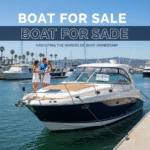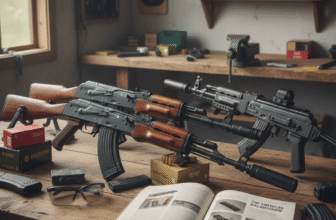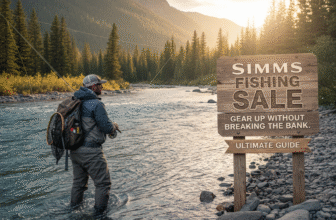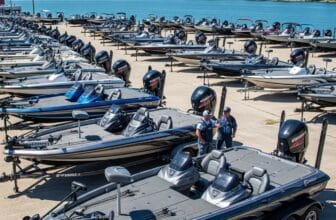
Boat for Sale: Your Ultimate Guide to Navigating the Waters of Boat Ownership
There’s a certain magic to the idea of owning a boat. It’s a vision painted with sun-drenched afternoons, the gentle lapping of waves against a hull, and the freedom to explore coastlines and lakes at your own pace. For many, seeing a “boat for sale” sign is the spark that ignites a lifelong dream. But turning that dream into a happy reality requires more than just enthusiasm; it demands research, planning, and a healthy dose of realism. Buying a boat is a significant investment, not just of money, but of time and energy. This comprehensive guide is your first mate, designed to help you navigate the entire process, from that initial spark of desire to the triumphant moment you cast off the lines for your maiden voyage. We’ll explore how to choose the right vessel, the pros and cons of new versus used, where to look, and the critical steps of inspection and closing the deal. So, grab a coffee, settle in, and let’s get you ready to find the perfect boat that’s waiting for you.
The Dream vs. The Reality: Are You Truly Ready for a Boat?
Before you start browsing online listings and falling in love with gleaming fiberglass, it’s crucial to have an honest conversation with yourself about the realities of boat ownership. The purchase price is just the tip of the iceberg; the real costs lie beneath the surface.
The Financial Wake: Beyond the sticker price, you need to budget for a host of recurring expenses that we call the “cost of ownership.”
- Insurance: Just like a car, your boat needs to be insured against liability, damage, and theft. The cost will vary wildly based on the boat’s value, size, engine power, and where you plan to use it.
- Storage/Docking: Unless you have a large property and a small boat, you’ll need to pay for storage. This could mean a slip at a marina (which can be very expensive, especially in prime locations), a spot in a dry-stack facility, or winter storage fees in colder climates.
- Maintenance: Boats live in a harsh environment of water and sun. They require constant upkeep. This includes regular engine servicing (oil changes, impeller replacements), bottom painting to prevent marine growth, waxing the hull to protect the gelcoat, and servicing various systems like plumbing and electrical. A good rule of thumb is to budget 10% of the boat’s value for annual maintenance.
- Fuel: Marine fuel is often more expensive than what you put in your car, and boats, especially powerful motorboats, can be very thirsty. Your fuel costs will be directly tied to how often and how far you travel.
- Gear and Upgrades: You’ll need essential safety gear mandated by the U.S. Coast Guard (life jackets, flares, fire extinguishers), plus docking lines, fenders, an anchor, and more. And then there are the fun upgrades—new electronics, a better sound system, or watersports toys.
The Time Commitment: Owning a boat isn’t just about sunny Saturdays on the water. There’s the pre-launch prep, cleaning up after a day out, and the ongoing maintenance tasks. It’s a hobby that requires hands-on involvement. If your weekends are already packed, consider whether you have the time to truly enjoy and care for a boat. If the answer to these considerations is still a resounding “yes,” then congratulations—let’s find you a boat!

Choosing Your Perfect Vessel: What Type of Boat is Right for You?
The term “boat” is incredibly broad. The right boat for you depends entirely on what you want to do on the water. Thinking about your primary activities will narrow down your search from thousands of options to a manageable few. Let’s break down some of the most popular categories in the USA.
For the Angler: Fishing Boats
If your goal is to chase the big one, you’ll want a vessel designed for it. Fishing boats are purpose-built with features like rod holders, livewells (to keep bait or catch alive), and open cockpits for casting.
- Center Console: Immensely popular, especially in saltwater environments. The helm station is in the center, allowing for 360-degree fish-fighting access. They are versatile, rugged, and great for both inshore and offshore fishing.
- Bass Boat: The freshwater equivalent of a sports car. These boats have a low profile, powerful outboard motors for getting to fishing spots fast, and large casting decks at the bow and stern.
- Bay Boat: A hybrid that bridges the gap between a flats boat and a center console. They have a shallow draft to navigate bays and estuaries but enough hull to handle some light chop in open water.
For the Entertainer and Cruiser: Day Boats and Cruisers
If your perfect day involves relaxing with family and friends, cruising to a waterfront restaurant, or finding a secluded cove for a swim, these boats are for you.
- Bowrider: A classic American runabout. They feature an open bow area with extra seating, making them fantastic for day-tripping with groups. They are versatile enough for casual fishing or pulling a tube.
- Pontoon Boat: The ultimate party platform. Modern pontoons are more like floating living rooms, with plush couches, tables, sound systems, and even slides. They offer incredible stability and space, making them perfect for families with kids.
- Cabin Cruiser: These are your entry into overnight boating. They have a cabin with basic amenities like a small galley (kitchen), a head (bathroom), and sleeping berths. They’re ideal for weekend getaways.
For the Thrill-Seeker: Watersports Boats
If your heart beats faster at the thought of slalom skiing, wakeboarding, or surfing, you need a boat designed to create the perfect wake.
- Ski/Wakeboard Boats: These inboard-powered boats are engineered to create specific types of wakes. They often feature ballast systems (tanks that fill with water) to make the wake larger, and towers to elevate the tow rope for aerial maneuvers.
For the Purist: Sailboats
For those who prefer the quiet power of the wind, a sailboat offers a completely different connection to the water. They range from small, nimble day sailers perfect for an afternoon jaunt to large, blue-water cruising yachts capable of crossing oceans.
New vs. Used: The Great Debate
Once you’ve narrowed down the type of boat, the next big decision is whether to buy a brand-new vessel or a pre-owned one. Both paths have significant advantages and disadvantages.
The Allure of a New Boat
- Warranty: This is the single biggest advantage. A new boat comes with a manufacturer’s warranty on the hull, engine, and other components, providing immense peace of mind.
- Modern Technology: You get the latest in engine efficiency, hull design, and marine electronics (GPS, fishfinders, etc.).
- Pristine Condition: There’s nothing quite like the feeling of being the first owner. No dings, no scratches, no hidden history of neglect.
- The Downside: The cost. New boats are expensive, and like new cars, they experience their steepest depreciation in the first few years.
The Value of a Used Boat
- Significant Savings: The primary reason people buy used is the price. You can often get a much larger or better-equipped boat for the same money compared to buying new.
- Depreciation Buffer: The first owner has already absorbed the biggest hit in depreciation. Your investment will likely hold its value better over time.
- Included Gear: Used boats often come bundled with all the necessary (and expensive) gear, from safety equipment to electronics.
- The Downside: The risk. There’s no warranty, and the boat has a history you can’t be 100% sure of. Hidden mechanical or structural problems can turn a great deal into a money pit.
The Hunt: Where to Find Your Dream Boat for Sale
Now for the fun part: the search. There are several excellent avenues to explore, each with its own pros and cons.
- Boat Dealerships: The best place to look for new boats and often certified pre-owned vessels. They can help with financing, handle all the paperwork, and may accept your old boat as a trade-in.
- Yacht/Boat Brokers: A broker acts as an intermediary for the seller of a used boat, much like a real estate agent. A good broker can be an invaluable resource, helping you find suitable boats, navigate the survey process, and handle negotiations and closing paperwork.
- Online Marketplaces: Websites like Boat Trader, YachtWorld, and Boats.com are the go-to resources. They have thousands of listings from both dealers and private sellers, allowing you to search by type, size, price, and location.
- Private Sellers: You can often find great deals by buying directly from an owner through sites like Craigslist or Facebook Marketplace. However, this route requires the most due diligence, as you are on your own without the protections offered by a dealer or broker.
- Boat Shows: These are fantastic opportunities to see a huge variety of boats from different manufacturers all in one place. You can climb aboard, compare layouts, and talk directly to dealers and brand representatives without any pressure.
The Inspection and Sea Trial: Your Most Important Step
You’ve found a boat that looks perfect. It shines, the price is right, and you can already picture yourself at the helm. Slow down. This next phase—the due diligence phase—is the most critical part of the entire buying process. Skipping or rushing these steps is the number one cause of buyer’s remorse.
Step 1: The Personal Inspection. Go over the boat with a fine-tooth comb. Look for stress cracks in the fiberglass, especially around fittings and the transom (where the engine mounts). Check the condition of the upholstery and canvas. Open every hatch and look for signs of water intrusion or mold. Look at the wiring—is it neat and orderly or a “rat’s nest”?
Step 2: Hire a Marine Surveyor. For any boat of significant value, hiring an independent, accredited marine surveyor is non-negotiable. A surveyor is a trained professional who will conduct a multi-hour inspection of the boat’s hull, decks, propulsion systems, electrical systems, and more. They will provide you with a detailed written report outlining the boat’s condition, identifying any potential problems, and giving you an estimate of its fair market value. The cost of a survey is a small price to pay for the peace of mind it provides and can save you thousands in unexpected repairs. It also gives you powerful leverage for negotiation.
Step 3: The Sea Trial. A boat can look perfect sitting at the dock but reveal major issues once it’s underway. The sea trial is your chance to see how it performs on the water. During the trial, you should:
- Run the engine(s) at various speeds, from idle to wide-open throttle. Does it start easily? Does it overheat? Are there any unusual noises or vibrations?
- Test the steering and handling. Does it turn smoothly? Does it wander or pull to one side?
- Operate all the systems: bilge pumps, lights, electronics, trim tabs, etc. Make sure everything works as it should.
Making the Deal and Taking Ownership
With a successful survey and sea trial completed, you’re ready to finalize the purchase. Use the surveyor’s report to negotiate the final price. If it uncovered minor issues, it’s fair to ask the seller to either fix them before the sale or reduce the price accordingly. Once you agree on a price, you’ll sign a purchase agreement. This legally binding document outlines the terms of the sale, including the price, closing date, and any contingencies. Finally, ensure the paperwork is in order. You’ll need a clean title (or a Manufacturer’s Statement of Origin for a new boat) and a bill of sale. Your broker or dealer will typically handle this, but if you’re buying privately, you’ll need to manage the transfer of title and registration with your state’s DMV or equivalent agency.
Before you take possession, arrange for insurance. You will not be able to register the boat or dock it at a marina without proof of insurance. Once the keys are in your hand, your journey as a boat owner officially begins. Consider taking a boating safety course from the U.S. Coast Guard Auxiliary or a similar organization. It’s the best way to build your confidence and ensure that every trip you take is a safe and enjoyable one. Welcome to the club!







